A Discussion about the Rod Position in the Splitting Tensile Tests on Hollow Concrete Blocks
Abstract
1. Introduction
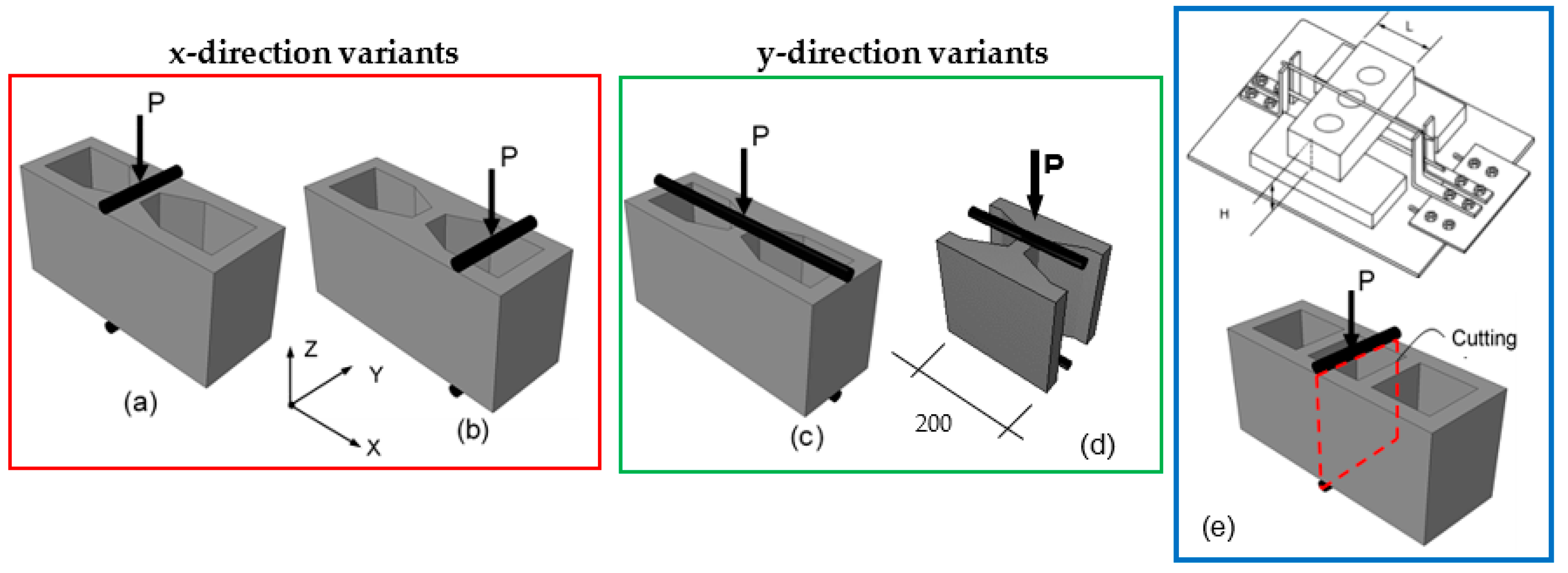
2. Materials and Methods
2.1. Axial Compressive Test
2.2. Splitting Tests
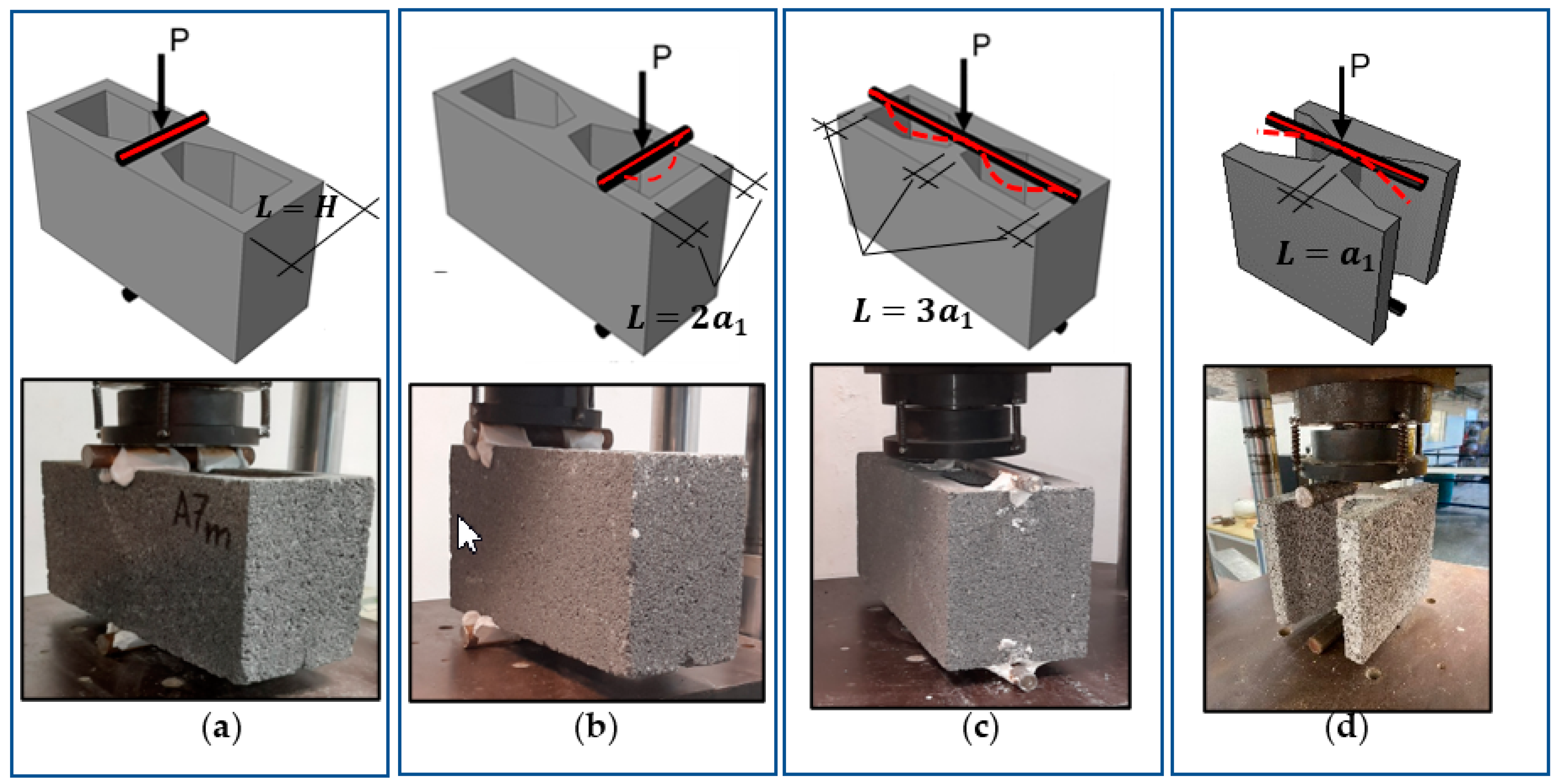
2.3. Direct Tensile Tests in X-Direction
3. Results and Discussion
3.1. Experimental Results
3.2. Statistical Analysis
3.3. Comparison with Other Studies
4. Conclusions
- The experimental results from the four different splitting tests showed that the corresponding setups had a significant effect on the computed tensile strength. For each different configuration, the tensile strength shall be different. In some cases, the strengths are greater, and they are smaller in others, i.e., the interaction of the test setup components biases the measured strength.
- In a splitting test, if the load is applied over the gross area, the tensile strength should not be computed over the net area, . This procedure is not consistent with the standard (ASTM C-1006). Furthermore, amongst all the analyzed variations, those results were the least meaningful.
- The splitting test on the net area in the x-direction overestimates the tensile strength.
- The experimental results suggest that when the compressive strength of the HCBs increases, the relative difference between the tensile strength over the gross and net area in the splitting tests is greater.
- This research is limited to HCBs with two holes and a compressive strength of 11.62 MPa on the net area.
Supplementary Materials
Author Contributions
Funding
Institutional Review Board Statement
Informed Consent Statement
Data Availability Statement
Acknowledgments
Conflicts of Interest
Nomenclature
| Ultimate strain in compression | |
| Strain related to the maximum stress in compression | |
| HCB uniaxial compressive strength over the gross area, MPa | |
| HCB uniaxial compressive strength over the net area, MPa | |
| Elastic modulus over the gross area, in compression, MPa | |
| Elastic modulus over the net area, in compression, MPa | |
| Splitting tensile strength in the x-direction over the net area, MPa | |
| Splitting tensile strength in the x-direction over the gross area, MPa | |
| Splitting tensile strength in the y-direction, MPa | |
| Splitting tensile strength in the y-direction, 200 mm from the central region of the block, MPa | |
| Splitting tensile strength in the x-direction over the gross area using the net area to compute the splitting strength |
References
- Zhu, F.; Zhou, Q.; Wang, F.; Yang, X. Spatial variability and sensitivity analysis on the compressive strength of hollow concrete block masonry wallettes. Constr. Build. Mater. 2017, 140, 129–138. [Google Scholar] [CrossRef]
- Zhao, Y.; Wang, F. Experimental studies on behavior of fully grouted reinforced-concrete masonry shear walls. Earthq. Eng. Eng. Vib. 2015, 14, 743–757. [Google Scholar] [CrossRef]
- Sassine, E.; Cherif, Y.; Dgheim, J.; Antczak, E. Investigation of the mechanical and thermal performances of concrete hollow blocks. SN Appl. Sci. 2020, 2, 2006. [Google Scholar] [CrossRef]
- Álvarez-Pérez, J.; Chávez-Gómez, J.H.; Terán-Torres, B.T.; Mesa-Lavista, M.; Balandrano-Vázquez, R. Multifactorial behavior of the elastic modulus and compressive strength in masonry prisms of hollow concrete blocks. Constr. Build. Mater. 2020, 241, 118002. [Google Scholar] [CrossRef]
- Fonseca, F.S.; Fortes, E.S.; Parsekian, G.A.; Camacho, J.S. Compressive strength of high-strength concrete masonry grouted prisms. Constr. Build. Mater. 2019, 202, 861–876. [Google Scholar] [CrossRef]
- Pereira, J.M.; Lourenço, P.B. Experimental Characterization of Masonry and Masonry Components at High Strain Rates. J. Mater. Civ. Eng. 2017, 29, 1–10. [Google Scholar] [CrossRef]
- Caldeira, F.E.; Nalon, G.H.; de Oliveira, D.S.; Pedroti, L.G.; Ribeiro, J.C.L.; Ferreira, F.A.; de Carvalho, J.M.F. Influence of joint thickness and strength of mortars on the compressive behavior of prisms made of normal and high-strength concrete blocks. Constr. Build. Mater. 2020, 234, 117419. [Google Scholar] [CrossRef]
- Madhavi, K.; Renuka, M.; Jagadish, K. Split tensile strength of brick masonry. Int. J. Civ. Eng. Comput. 2017, 6, 1–8. [Google Scholar]
- Bolhassani, M.; Hamid, A.A.; Lau, A.C.; Moon, F. Simplified micro modeling of partially grouted masonry assemblages. Constr. Build. Mater. 2015, 83, 159–173. [Google Scholar] [CrossRef]
- Mojsilović, N. Tensile strength of clay blocks: An experimental study. Constr. Build. Mater. 2011, 25, 4156–4164. [Google Scholar] [CrossRef]
- Álvarez, J.; Mesa, M.; Chávez, J. Splitting and direct tensile tests comparison in hollow concrete blocks. In Proceedings of the 14TH Canadian Masonry Symposium, Virtually, 16–19 May 2021. [Google Scholar]
- Haach, V.G.; Vasconcelos, G.; Lourenço, P. Development of a new test for determination of tensile strength of concrete blocks. In Proceedings of the 12th Canadian Masonry Symposium, Vancouver, BA, Canada, 2–5 June 2013. [Google Scholar]
- Almeida, J.C.; Lourenço, P.; Barros, J. Experimental investigation of bricks under uniaxial tensile testing. Mason. Int. 2005, 18, 11–20. [Google Scholar]
- Almeida, J.C.; Li, P.B.; Barros, J. Characterization of¸ brick and brick–mortar interface under uniaxial tension. In Proceedings of the 7th International Seminar on Structural Masonry, CEFET-MG, Belo Horizonte, Brazil, 2 June 2002; pp. 67–76. [Google Scholar]
- Santhakumar, A.R.; Ashok, S. Tensile strength of brick masonry. In Proceedings of the 9th Canadian Masonry Symposium; University of New Brunswick: Fredericton, NB, Canada, 2015. [Google Scholar]
- McBurneyz, J.W. Strength of brick in TENSION1. J. Am. Ceram. Soc. 1928, 11, 114–117. [Google Scholar] [CrossRef]
- Barbosa, C.D.S.; Hanai, J. Strength and deformability of hollow concrete blocks: Correlation of block and cylindrical sample test results. Rev. Ibracon Estrut. E Mater. 2009, 2, 85–99. [Google Scholar] [CrossRef]
- Li, J.; Masia, M.J.; Stewart, M.G.; Lawrence, S.J. Spatial variability and stochastic strength prediction of unreinforced masonry walls in vertical bending. Eng. Struct. 2014, 59, 787–797. [Google Scholar] [CrossRef]
- Zhang, W.; Deng, M.; Guo, L.; Qiu, Z.; Yang, S.; Dong, Z. Seismic Strengthening of Unreinforced Concrete Block Masonry Walls with High Ductile Fiber-Reinforced Concrete (HDC). J. Earthq. Eng. 2022, 1–23. [Google Scholar] [CrossRef]
- Álvarez-Pérez, J.; Mesa-Lavista, M.; Chávez-Gómez, J.H.; Miguel, G.F.-S. Experimental investigation on tensile strength of hollow concrete blocks. Mater. Struct. 2021, 54, 26. [Google Scholar] [CrossRef]
- Oliveira, L.M.F. Numerical and Experimental Study of the Behavior of Vertical Interfaces of Interconnected Structural Masonry Walls; São Carlos School of Engineering, University of São Paulo: Sao Carlos, Brazil, 2014. [Google Scholar]
- Rizzatti, E.; Roman, H.R.; Mohamad, G.; Nakanishi, E. Mechanical behavior analysis of small-scale modeling of ceramic block masonry structures: Geometries effect. Rev. Ibracon Estrut. E Mater. 2012, 5, 702–736. [Google Scholar] [CrossRef]
- Dean, S.W.; Parker, C.K.; Tanner, J.E.; Varela, J.L. Evaluation of ASTM Methods to Determine Splitting Tensile Strength in Concrete, Masonry, and Autoclaved Aerated Concrete. J. ASTM Int. 2007, 4, 12. [Google Scholar] [CrossRef]
- Izquierdo, I.S.; Izquierdo, O.S.; Ramalho, M.A.; Taliercio, A. Sisal fiber reinforced hollow concrete blocks for structural applications: Testing and modeling. Constr. Build. Mater. 2017, 151, 98–112. [Google Scholar] [CrossRef]
- De Oliveira, L.M.F.; Corrêa, M.R.S. Numerical and experimental analysis of the shear capacity of interconnected concrete block walls. Ambiente Construído 2017, 17, 25–37. [Google Scholar] [CrossRef][Green Version]
- ASTM-C-1006; Standard Test Method for Splitting Tensile Strength of Masonry Units. Copyright © ASTM International: West Conshohocken, PA, USA, 2013; p. 3.
- Bolhassani, M.; Hamid, A.; Moon, F. Enhancement of lateral in-plane capacity of partially grouted concrete masonry shear walls. Eng. Struct. 2016, 108, 59–76. [Google Scholar] [CrossRef]
- NTC-M. (Standard) Complementary technical standards for design and construction of masonry structures (in Spanish) (mexican masonry code). In Gaceta Oficial del Distrito Federal, Tomo I, N°.103-BIs.; 2017; p. 284. Available online: http://cgservicios.df.gob.mx/prontuario/vigente/745.pdf (accessed on 27 November 2022).
- NMX-ONNCCE-C-404; Bloques, Tabiques O Ladrillos Y Tabicones Para Uso Estructural–Especificaciones Y Métodos De Ensayo. Organismo Nacional de Normalización y Certificación de la Construcción y Edificación S.C: Ciudad de México, Mexico, 2012; p. 17.
- NMX-C-036-ONNCCE-2013; Resistencia a la Compresión de Bloques, Tabiques o Ladrillos y Tabicones y Adoquines. Organismo Nacional de Normalización y Certificación de la Construcción y Edificación S.C: Ciudad de México, Mexico, 2013; p. 10.
- 18a, A.C.C.M.; Standard Test Methods for Sampling and Testing Concrete Masonry Units and Related Units. ASTM International: West Conshohocken, PA, USA, 2018; p. 17.
- ASTM-C-90-16a; Standard Specification for Loadbearing Concrete Masonry Units. ASTM International: West Conshohocken, PA, USA, 2016; p. 5.
- ASTM-C-129; Standard Specification for Nonloadbearing Concrete Masonry Units. ASTM International: West Conshohocken, PA, USA, 2017; p. 3.
- NMX-C-404-ONNCCE-2012; Bloques, Tabiques o Ladrillos y Tabicones Para uso Estructural. Organismo Nacional de Normalización y Certificación de la Construcción y Edificación S.C: Ciudad de México, Mexico, 2012; p. 17.
- Barbosa, C.S.; Hanai, J. Resistência e deformabilidade de blocos vazados de concreto e suas correlações com as propriedades mecânicas do material constituinte. Cad. Eng. Estrut. 2006, 8, 45–74. [Google Scholar]
- García, J.M.; Bonett, R.; Ledezma, C. Analytical Model for Compression Behavior of Hollow Concrete Blocks. Rev. De La Construcción 2013, 12, 76–82. [Google Scholar]
- Yang, Y.; Massicotte, B.; Genikomsou, A.S.; Pantazopoulou, S.J.; Palermo, D. Comparative investigation on tensile behaviour of UHPFRC. Mater. Struct. 2021, 54, 147. [Google Scholar] [CrossRef]
- Montgomery, D.C.; Runger, G. Applied Statistics and Probability for Engineers, 3rd ed.; Wiley: Hoboken, NJ, USA, 2003. [Google Scholar]
- Álvarez-Pérez, J.; Mesa-Lavista, M.; Chávez-Gómez, J.H.; Cavazos-De-Lira, D.; Terán-Torres, B.T. Splitting test experimental dataset of hollow concrete blocks. Data Brief 2021, 39, 107646. [Google Scholar] [CrossRef]
- Mesa-Lavista, M. Results of the Splitting Tests of Hollow Concrete Blocks; Mendeley-Data: V2; Mendeley-Data, Ed.; Data Archiving and Networked Services (DANS): The Hague, The Netherlands, 2021. [Google Scholar] [CrossRef]
- Thomas, K.; O’Leary, D.O. Tensile strength tests on two types of brick. In Proceedings of the Second InternationaI Brick Masonry 1970, Stoke-on-Trent, UK, 12–15 April 1970. [Google Scholar]
- Hamid, A.A.; Drysdale, R. Effect of Strain Gradient on Tensile Strength of Concrete Blocks; Borchelt, J., Ed.; ASTM International: West Conshohocken, PA, USA, 1982; pp. 57–65. [Google Scholar]
- Barbosa, C.S.; Hanai, J. Strength and deformability of hollow concrete blocks and their correlations with mechanical properties of constituent material. In Proceedings of the in 10th Canadian Masonry Symposium, Banff, AB, Canada, 8–12 June 2005; pp. 8–12. [Google Scholar]
- Van Cauwelaert, F. The split tensile test applied to rectangular concrete blocks—Numerical and analytical approach. Mater. Struct. 1996, 29, 494–499. [Google Scholar] [CrossRef]
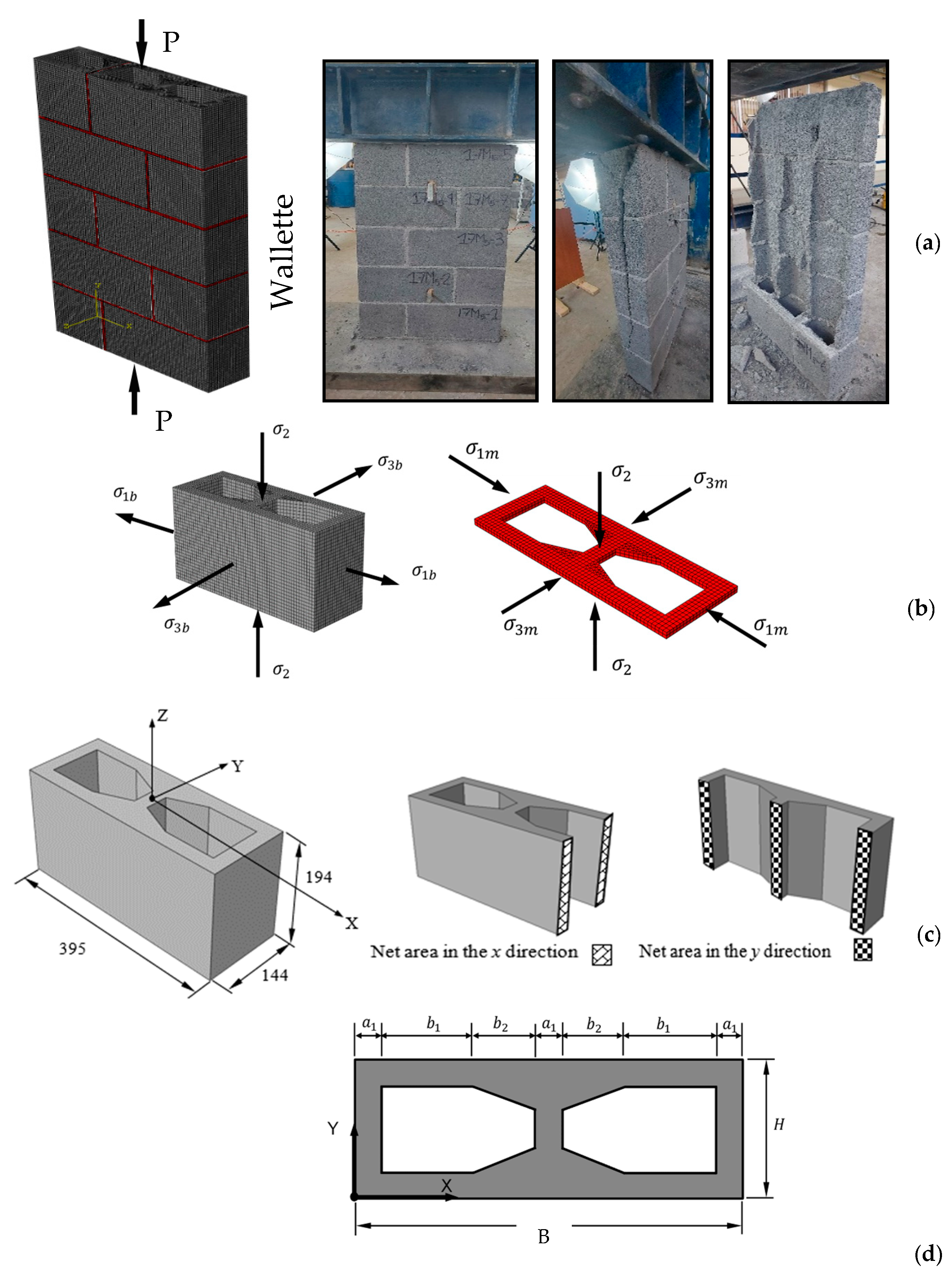
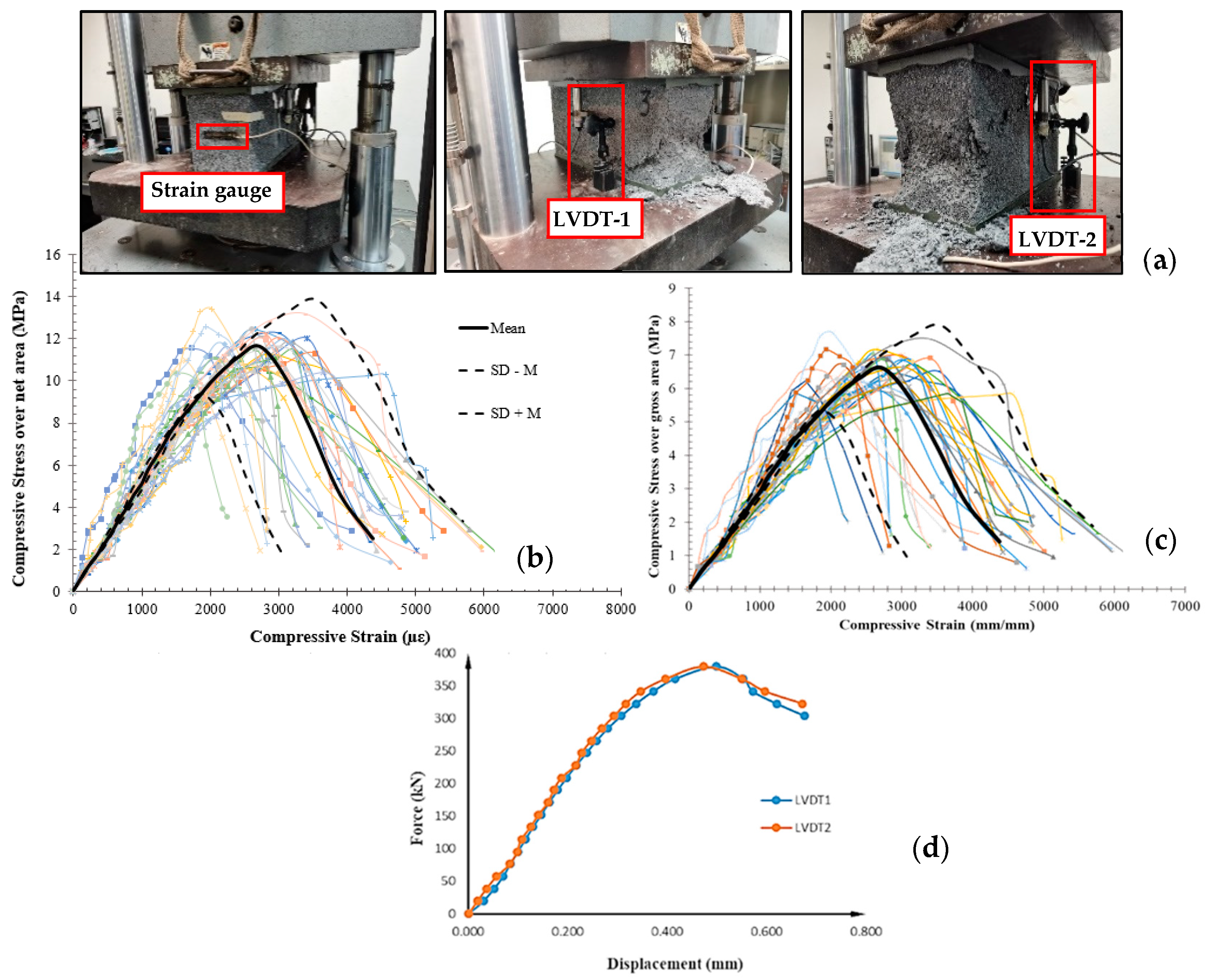
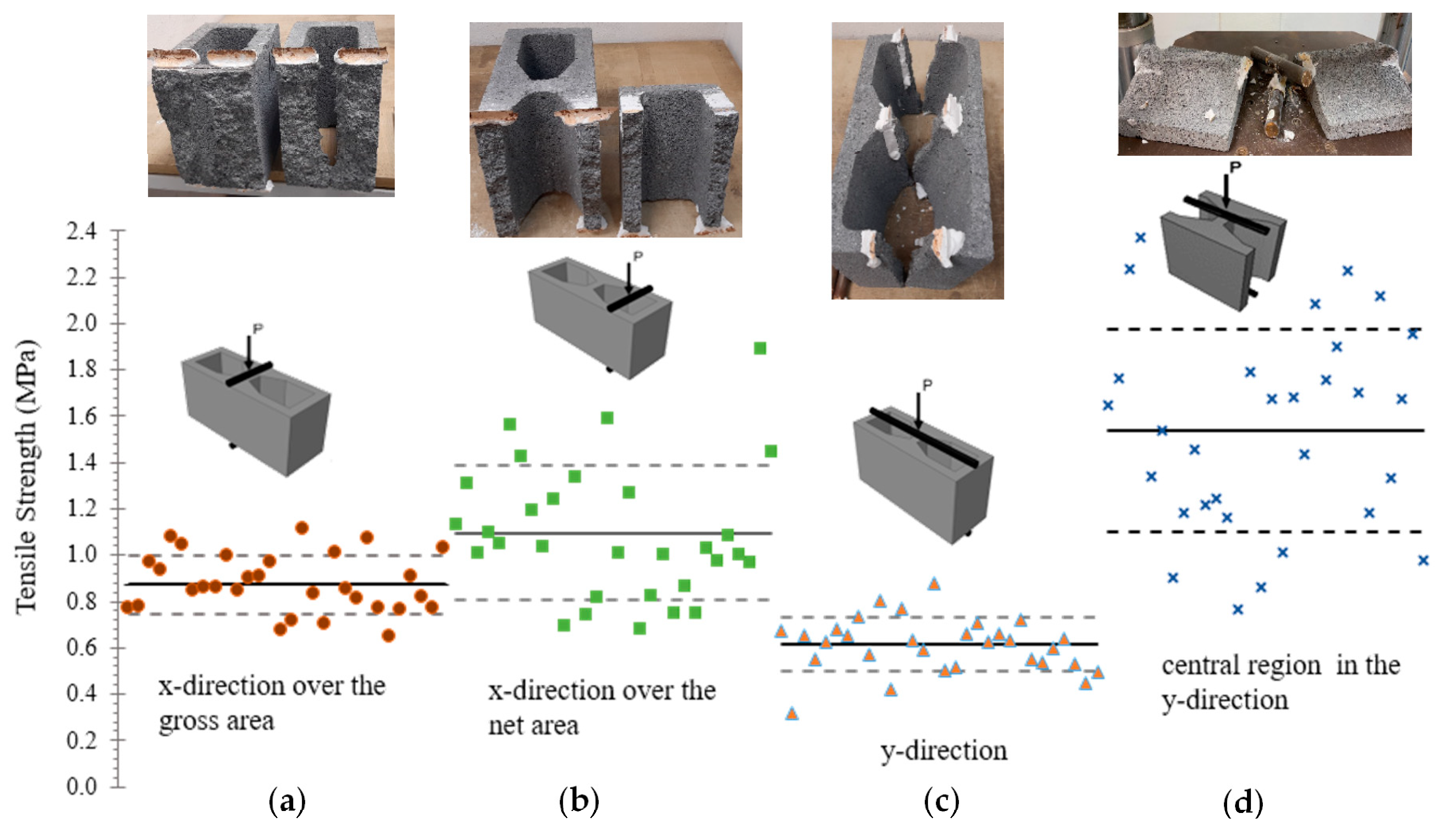
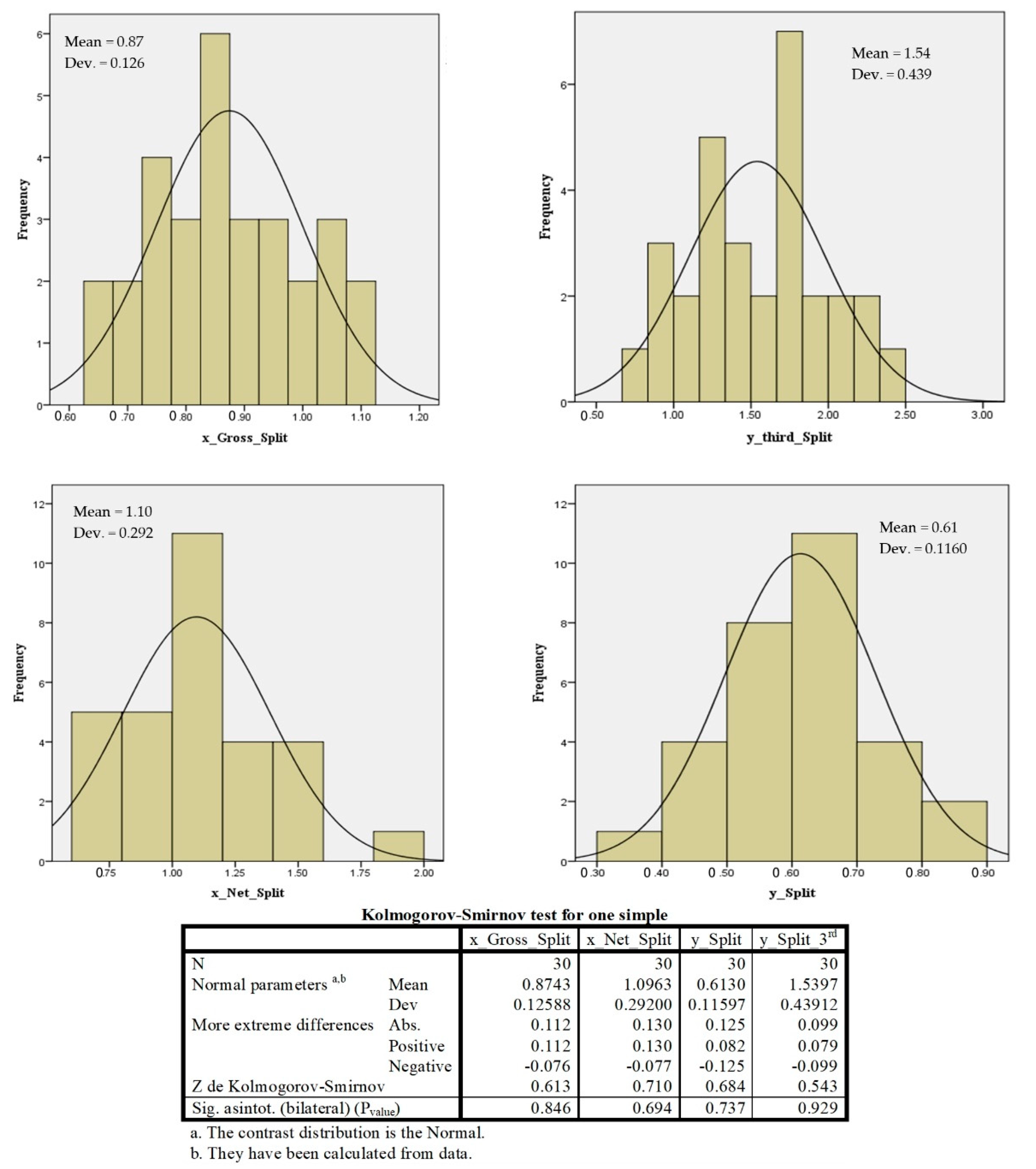

| Max. Load (kN) | (MPa) | (MPa) | µ | |||||
|---|---|---|---|---|---|---|---|---|
| Mean | 377 | 6.61 | 11.62 | 3032 | 5326 | 0.0027 | 0.0044 | 0.06 |
| SD | 26.23 | 0.47 | 0.81 | 722 | 1269 | 0.0007 | 0.0011 | 0.02 |
| COV | 7% | 7% | 7% | 24% | 24% | 25% | 24% | 27% |
| x-Direction over the Gross Area (Figure 1a) | ||||||||||
|---|---|---|---|---|---|---|---|---|---|---|
| L (mm) | ||||||||||
| Mean | 395 | 145 | 195 | 27 | 101 | 54 | 145 | 38.87 | 0.87 | 2.33 |
| SD | 0.68 | 0.76 | 0.78 | 0.49 | 0.97 | 0.66 | 0.76 | 5.64 | 0.13 | 0.33 |
| COV | 0.17% | 0.53% | 0.40% | 1.79% | 0.97% | 1.23% | 0.5% | 14.51% | 14.41% | 14.18% |
| refers to the first variation, where the strength is obtained using the net area but applying the load over the gross area [24]. | ||||||||||
| x-direction over the net area (Figure 1b) | ||||||||||
| L (mm) | ||||||||||
| Mean | 395 | 145 | 195 | 27 | 100 | 54 | 55 | 18.36 | 1.10 | |
| SD | 0.56 | 0.21 | 0.82 | 0.51 | 0.71 | 0.70 | 1.01 | 4.88 | 0.29 | |
| COV | 0.14% | 0.14% | 0.42% | 1.85% | 0.71% | 1.29% | 1.85% | 26.57% | 26.67% | |
| y-direction (Figure 1c) | ||||||||||
| L (mm) | ||||||||||
| Mean | 395 | 145 | 195 | 27 | 101 | 53 | 81 | 15.09 | 0.61 | |
| SD | 0.22 | 0.32 | 0.73 | 0.43 | 0.58 | 0.63 | 1.28 | 2.85 | 0.12 | |
| COV | 0.06% | 0.22% | 0.38% | 1.59% | 0.57% | 1.19% | 1.6% | 18.89% | 19.0% | |
| 200 mm from the central region of the block in the y-direction (Figure 1d) | ||||||||||
| L (mm) | ||||||||||
| Mean | 195 | 30 | 30 | 13.9 | 1.54 | |||||
| SD | 0.55 | 1.50 | 1.50 | 3.9 | 0.44 | |||||
| COV | 0.3% | 5.1% | 5.1% | 28% | 29% | |||||
| Variable | Levene Test p-Value | Mean Comparison | Statistical Difference | Relative Difference (RD) | Absolute Difference (AD) | Comparative | |
|---|---|---|---|---|---|---|---|
| 0.628 | Student-t test (p = 0.490) | Non-Difference | 3% | 3% |  |  | |
| 0.000 | Mann–Whitney U test (p = 0.000) | Difference | 159% | 143% | |||
| 0.002 | Mann–Whitney U test (p = 0.004) | Difference | 22% | 20% |  | ||
| 0.205 | Student-t test (p = 0.000) | Difference | 32% | 29% |  | ||
| 0.000 | Mann–Whitney U test (p = 0.000) | Difference | 71% | 64% |  | ||
| 0.001 | Mann–Whitney U test (p = 0.001) | Difference | 21% | 23% |  |  | |
| 0.000 | Mann–Whitney U test (p = 0.000) | Difference | 60% | 93% |  |  | |
| 0.417 | Student-t test (p = 0.000) | Difference | 30% | 26% |  |  | |
| 0.000 | Mann–Whitney U test (p = 0.000) | Difference | 43% | 26% |  |  | |
| 0.000 | Mann–Whitney U test (p = 0.000) | Difference | 44% | 49% |  |  | |
| 0.012 | Mann–Whitney U test (p = 0.000) | Difference | 40% | 44% |  |  | |
| 0.000 | Mann–Whitney U test (p = 0.000) | Difference | 168% | 146% |  | ||
| 0.339 | Student-t test (p = 0.000) | Difference | 80% | 123% |  | ||
| 1 | 2 | 3 | 4 | 5 | 6 | 7 | 8 | 9 | 10 | 11 | 12 | 13 | 14 |
|---|---|---|---|---|---|---|---|---|---|---|---|---|---|
| Series | |||||||||||||
| 11.62 | 0.077 | 0.075 | 0.094 | 28.83 | 0.075 | 0.053 | BB-1 | 14.0 | 1.3 | 0.09 | 17.63 | 3.13 | 0.178 |
| BB-2 | 17.7 | 1.9 | 0.11 | ||||||||||
| BB-3 | 26.0 | 3.1 | 0.12 | ||||||||||
| Current research 30 samples for each test | J. Álvarez et al. [11,20] 30 samples for each test | C. S. Barbosa and J. B. Hanai [17] 6 samples for each test | V. G. Haach, G. Vasconcelos, and P. B. Lourenço [12] 6 samples for each test | ||||||||||
| Tensile strength of the cut samples from the HCBs [12] : net/gross area ratio : Direct tensile test of HCBs | |||||||||||||
Disclaimer/Publisher’s Note: The statements, opinions and data contained in all publications are solely those of the individual author(s) and contributor(s) and not of MDPI and/or the editor(s). MDPI and/or the editor(s) disclaim responsibility for any injury to people or property resulting from any ideas, methods, instructions or products referred to in the content. |
© 2022 by the authors. Licensee MDPI, Basel, Switzerland. This article is an open access article distributed under the terms and conditions of the Creative Commons Attribution (CC BY) license (https://creativecommons.org/licenses/by/4.0/).
Share and Cite
Chávez-Gómez, J.H.; Álvarez-Pérez, J.; Mesa-Lavista, M.; Fajardo-San-Miguel, G.; Cavazos-de-Lira, D.; González-Alcorta, R. A Discussion about the Rod Position in the Splitting Tensile Tests on Hollow Concrete Blocks. Buildings 2023, 13, 96. https://doi.org/10.3390/buildings13010096
Chávez-Gómez JH, Álvarez-Pérez J, Mesa-Lavista M, Fajardo-San-Miguel G, Cavazos-de-Lira D, González-Alcorta R. A Discussion about the Rod Position in the Splitting Tensile Tests on Hollow Concrete Blocks. Buildings. 2023; 13(1):96. https://doi.org/10.3390/buildings13010096
Chicago/Turabian StyleChávez-Gómez, Jorge H., José Álvarez-Pérez, Milena Mesa-Lavista, G. Fajardo-San-Miguel, Diego Cavazos-de-Lira, and Ricardo González-Alcorta. 2023. "A Discussion about the Rod Position in the Splitting Tensile Tests on Hollow Concrete Blocks" Buildings 13, no. 1: 96. https://doi.org/10.3390/buildings13010096
APA StyleChávez-Gómez, J. H., Álvarez-Pérez, J., Mesa-Lavista, M., Fajardo-San-Miguel, G., Cavazos-de-Lira, D., & González-Alcorta, R. (2023). A Discussion about the Rod Position in the Splitting Tensile Tests on Hollow Concrete Blocks. Buildings, 13(1), 96. https://doi.org/10.3390/buildings13010096






